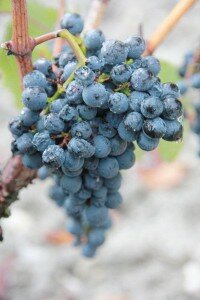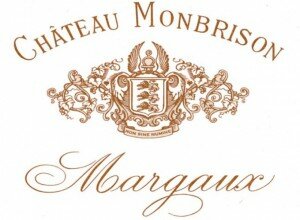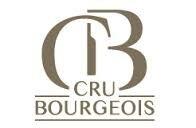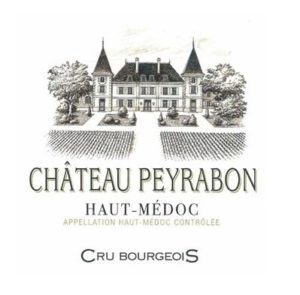 You’ll be happy to know that the weather currently in Bordeaux is what we normally experience in the UK, it’s persisting with rain and I am sat in my hotel room this evening looking out on a wet and soggy Bordeaux. Today I visited the length and breadth of the Left Bank, starting at Chateau Lafon Rochet which was hosting the Paulliac and Saint Estephe AOC tastings.
You’ll be happy to know that the weather currently in Bordeaux is what we normally experience in the UK, it’s persisting with rain and I am sat in my hotel room this evening looking out on a wet and soggy Bordeaux. Today I visited the length and breadth of the Left Bank, starting at Chateau Lafon Rochet which was hosting the Paulliac and Saint Estephe AOC tastings.
I bumped into Basile Tesseron who runs Lafon Rochet for his family. He is a very warm and charming character and, as seems to be the fashion for the younger men nowadays, he has grown a full beard. Basile showed me a video that he has recently made which is extremely informative and he promised to send me a copy which I’ll ultimately put on my website, so watch this space.
 The Petit Verdot grape in the 2013 blends is making all the difference this year. Those wines that do contain it seem to be the better for it and I have noticed that the chateaux who have used this grape have produced wines that I have generally preferred. Petit Verdot ripens late and is grown in smaller quantities than the major varieties of Cabernet Sauvignon, Merlot and to some extent Cabernet Franc. It adds colour, tannin and structure to the blend.
The Petit Verdot grape in the 2013 blends is making all the difference this year. Those wines that do contain it seem to be the better for it and I have noticed that the chateaux who have used this grape have produced wines that I have generally preferred. Petit Verdot ripens late and is grown in smaller quantities than the major varieties of Cabernet Sauvignon, Merlot and to some extent Cabernet Franc. It adds colour, tannin and structure to the blend.
In previous vintages you normally see between 1 – 3% used in the blend but it has been used in higher quantities for 2013. It seems to have added a certain ‘je ne sais quoi’ to the vintage, adding richness and roundness to the wines.
Pauillac and Saint Estephe
The wines on show from Pauillac and Saint Estephe showed reasonably well given the trying year that the winemakers had endured. I retasted Chateau d’Armailhac and Clerc Milon and my disappointment remained the same as when first tasted.
The wines presented from Saint Estephe all showed similar characteristics and had good colour and balance – they will be good drinking wines.
Chateau Lynch Bages
The wine from Pauillac that I thought worthy of note was Lynch Bages. It’s a blend of 72% Cabernet Sauvignon, 30% Merlot, 6% Cabernet Franc, 2% Petit Verdot. This had a nice deep crimson colour, was very well balanced in the mouth with rich fruit. It was lacking a bit of depth compared to previous vintages but will be a very nice drinking wine when ready.
Saint Julien
I visited Chateau Lagrange which was holding the tastings for the Saint Julien AOC. I must admit Lagrange really is a beautiful chateau with its small lake in front of the chateau home to a family of swans at the moment. Here, I also had the opportunity to retaste Chateau Leoville Poyferre and this reaffirmed my earlier opinion that it will make a good wine.
In the main the wines from Saint Julien showed well. Petit Verdot was used in the blends of those that I enjoyed most, for example Chateau Beychevelle had 9% Petit Verdot , Gloria 5%, Lagrange and Talbot both had 4%. In particular I must highlight Chateau Branaire Ducru:
Chateau Branaire Ducru
Branaire Ducru is a blend of 5% Petit Verdot, 63% Cabernet Sauvignon, 31% Merlot and 1% Cabernet Franc and is a rich crimson in the glass. It has good fruit on the nose and a well balanced structure in the mouth with good length.
 Margaux
Margaux
At Chateau Marquis de Terme I tasted the wines from the Margaux AOC and I thought these were good presentations. Once again I preferred those where Petit Verdot had a hand in the blend: Chateau du Tertre had 5% Petit Verdot, Rauzan Segla 2% and Siran 10%.
Chateau Prieure Lichine (5% Petit Verdot) and Chateau Kirwan (10% Petit Verdot) came across very well. They picked the grapes 10 days earlier than anticipated at Kirwan and the entire village joined in – as they have done for the last 50 years. Although they have produced a good wine under the circumstances production is down 35%.
Two wines that stood out for me were Chateau Montbrison and Chateau Lascombes.
 Chateau Montbrison
Chateau Montbrison
With a blend of 60% Cabernet Sauvignon, 20% Merlot, 7% Cabernet Franc and 5% Petit Verdot Montbrison was reasonably deep in colour with good, elegant fruit on the nose and a nice balance between fruit, tannins and acidity in the mouth with good length.
Chateau Lascombes
Lascombes with a blend of 45% Cabernet Sauvignon, 50% Merlot and 5% Petit Verdot was definitely a few degrees above the rest. A nice crimson in the glass it had a good layer of fruit on the nose and good balance of cassis and blackcurrant fruit in the mouth with a touch of violets and spice.
Over lunch I met the Director at Lascombes, Dominic Befve, and had a long chat with him about his wine and how he had coped with the difficult vintage. Dominic said that he had enjoyed it because it had proved to be a challenge: ‘it’s easy to make good wine in a good year but the challenge is making it in a demanding year’.
Medoc, Haut Medoc, Moulis and Listrac
I visited Chateau Clarke to taste the wines from the Haut Medoc, Moulis and Listrac AOCs. I wasn’t looking forward to the tasting as in the past these wines have not suited my palate and I used to find the tannins harsh. I was genuinely surprised to find that this was not the case with the 2013 vintage. It proved to be a pleasant tasting with the wines presenting very well, although one or two wines were over extracted. Two wines to highlight are Chateau Chasse Spleen and Chateau Cantermerle.
Chateau Chasse Spleen
Made with a blend of 60% Cabernet Sauvignon, 33% Merlot and 7% Petit Verdot this was slightly lighter in colour than usual but had a clean, fresh nose with nice freshness of fruit in the mouth. There w ere hints of tannins but it was well balanced and I think this could be a very nice easy drinking wine when the time is right.
ere hints of tannins but it was well balanced and I think this could be a very nice easy drinking wine when the time is right.
Chateau Cantermerle
Chateau Cantermerle (55% Cabernet Sauvignon, 30% Merlot, 10% Cabernet Franc and 5% Petit Verdot) was a good crimson in the glass with good fresh red fruit on the nose. Nicely rounded and well balanced in the mouth with rich blackberry fruit and good length.
 Sauternes and Barsac Dry and Sweet Whites
Sauternes and Barsac Dry and Sweet Whites
At Chateau La Lagune I tasted the wines of Sauternes and Barsac. 2013 is definitely a vintage that will be remembered for its beautiful dry and sweet whites from these AOCs. All the wines I tasted presented very well indeed. The more I taste the sweet wines the more aware I become of their great versatility with food. They make fantastic pairings with strong and salty Roquefort cheese, enhance dishes in rich tangy sauces such as Duck al’Orange and are superb with spicy Indian cuisine – try them with your favourite curry, Balti or Madras, whatever your preference. Two wines that struck a real note with me were Chateau Doisy Daene and Chateau Guiraud.
Chateau Doisy Daene
Chateau Doisy Daene is made with a blend of 90% Semillon and 10% Sauvignon Blanc and is a rich gold colour with fresh white summer fruits on the nose. Well rounded in the mouth it offers opulent peach and good acidity. A lovely wine.
Chateau Guiraud
A blend of 65% Semillon and 35% Sauvignon Blanc Chateau Guiraud was honey hued in the glass with good soft white fruits on the nose. Good acidity, nice and fresh with hints of nectarine and honeysuckle. Nicely rounded. Another lovely wine.
 Crus Bourgeois
Crus Bourgeois
I completed the day with a visit to the Crus Bourgeois tastings at Chateau d’Arsac. I am a great believer that it is here that you will find the true reflection of any vintage as these are usually Petit Chateaux who don’t necessarily have the finance to take them into the high tech realms that the big chateaux can afford. These are real artisan chateaux with great history and with around 240 wines on display I had a very good selection to go at. I hasten to add that I didn’t taste all 240 but chose a selection from each AOC.
Very few people seem to visit the Crus Bourgeois tastings compared to the bigger tasting events. The local wine enthusiasts do and this tells me something. I think that the Crus Bourgeois are where the true value is going to come from this year – and maybe in the future. These wines are made by passionate traditional winemakers who make quality wines that many overlook.
The wines reflected what the larger chateaux had provided in terms of quality in a difficult year. One or two were over extracted but you can’t blame them if yields are down. I retasted Chateau La Croix from Leoville Poyferre (Saint Estephe) and reaffirmed my findings on Day 1 – it will make a very nice wine. Wines to note are:
Chateau Plantey (Paulliac) is a blend of 45% Cabernet Sauvignon and 55% Merlot. I thought this was charming.
Chateau d’Arsac (Margaux) is a blend of 67% Cabernet Sauvignon and 33% Merlot.
Chateau Cissac (Haut Medoc) is a blend of 70% Cabernet Sauvignon, 32% Merlot and 8% Petit Verdot. This will be a very good drinking wine when the time is right.
Chateau Lamothe Cissac (Medoc) is a blend of 58% Cabernet sauvignon, 35% Merlot, 2% Cabernet Franc and 5% Petit Verdot.
Chateau Le Monteil d’Arsac (Haut Medoc) is a blend of 48% Cabernet sauvignon and 52% Merlot.
 Chateau Peyrabon (Haut Medoc) is a blend of 59% Cabernet Sauvignon, 35% merlot, 4% Cabernet Franc and 2% Petit Verdot.
Chateau Peyrabon (Haut Medoc) is a blend of 59% Cabernet Sauvignon, 35% merlot, 4% Cabernet Franc and 2% Petit Verdot.
Chateau Senejac (Haut Medoc) is a blend of 48% Cabernet Sauvignon, 37% Merlot, 11% Cabernet Franc and 4% Petit Verdot. Followers of Senejac will not be disappointed.
Tomorrow I will be visiting the Graves and Pessac Leognan tastings at Chateau Malartic Lagraviere. I will also be tasting Chateau Haut Bailly and am looking forward to having lunch at Domaine de Chevalier. Olivier Bernard always treats us to a jolly good spread and some wonderful wines. I will post my findings on Friday and sum up the vintage on Monday.

